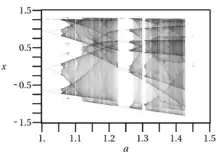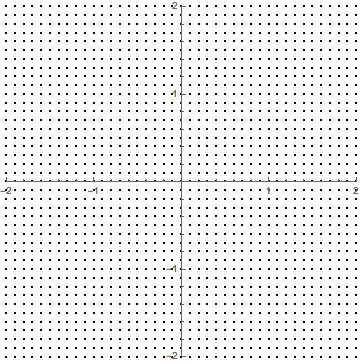Hénon map
The Hénon map , sometimes called Hénon-Pomeau attractor/map, [1] is a discrete-time dynamical system. It is one of the most studied examples of dynamical systems that exhibit chaotic behavior. The Hénon map takes a point (xn, yn) in the plane and maps it to a new point


The map depends on two parameters, a and b, which for the classical Hénon map have values of a = 1.4 and b = 0.3. For the classical values the Hénon map is chaotic. For other values of a and b the map may be chaotic, intermittent, or converge to a periodic orbit. An overview of the type of behavior of the map at different parameter values may be obtained from its orbit diagram.
The map was introduced by Michel Hénon as a simplified model of the Poincaré section of the Lorenz model. For the classical map, an initial point of the plane will either approach a set of points known as the Hénon strange attractor, or diverge to infinity. The Hénon attractor is a fractal, smooth in one direction and a Cantor set in another. Numerical estimates yield a correlation dimension of 1.25 ± 0.02[2] and a Hausdorff dimension of 1.261 ± 0.003[3] for the attractor of the classical map.
Attractor

The Hénon map maps two points into themselves: these are the invariant points. For the classical values of a and b of the Hénon map, one of these points is on the attractor:
This point is unstable. Points close to this fixed point and along the slope 1.924 will approach the fixed point and points along the slope -0.156 will move away from the fixed point. These slopes arise from the linearizations of the stable manifold and unstable manifold of the fixed point. The unstable manifold of the fixed point in the attractor is contained in the strange attractor of the Hénon map.
The Hénon map does not have a strange attractor for all values of the parameters a and b. For example, by keeping b fixed at 0.3 the bifurcation diagram shows that for a = 1.25 the Hénon map has a stable periodic orbit as an attractor.
Cvitanović et al. have shown how the structure of the Hénon strange attractor can be understood in terms of unstable periodic orbits within the attractor.

Decomposition
The Hénon map may be decomposed into an area-preserving bend:
- ,
a contraction in the x direction:
- ,
and a reflection in the line y = x:
- .
One Dimensional Decomposition
The Hénon map may also be deconstructed into a one dimensional map, defined similarly to the Fibonacci Sequence.
Special Cases and Low Period Orbits
If one solves the One Dimensional Hénon Map for the special case:
One arrives at the simple quadradic:
Or
The quadratic formula yields:
In the special case b=1, this is simplified to
If, in addition, a is in the form the formula is further simplified to
In practice the starting point (X,X) will follow a 4-point loop in two dimensions passing through all quadrants.
History
In 1976 France, the Lorenz attractor is analyzed by the physicist Yves Pomeau who performs a series of numerical calculations with J.L. Ibanez.[4] The analysis produces a kind of complement to the work of Ruelle (and Lanford) presented in 1975. It is the Lorenz attractor, that is to say the one corresponding to the original differential equations, and its geometric structure that interest them. Pomeau and Ibanez combine their numerical calculations with the results of a mathematical analysis, based on the use of Poincaré sections. Stretching, folding, sensitivity to initial conditions are naturally brought in this context in connection with the Lorenz attractor. If the analysis is ultimately very mathematical, Pomeau and Ibanez follow, in a sense, a physicist approach, experimenting the Lorenz system numerically.
Two openings are brought specifically by these experiences. They make it possible to highlight a singular behavior of the Lorenz system: there is a transition, characterized by a critical value of the parameters of the system, for which the system switches from a strange attractor position to a configuration in limit cycle. The importance will be revealed by Pomeau himself (and a collaborator, Paul Manneville) through the "scenario" of Intermittency, proposed in 1979.
The second path suggested by Pomeau and Ibanez is the idea of realizing dynamical systems even simpler than that of Lorenz, but having similar characteristics, and which would make it possible to prove more clearly "evidences" brought to light by numerical calculations. Since the reasoning is based on Poincaré's section, he proposes to produce an application of the plane in itself, rather than a differential equation, imitating the behavior of Lorenz and its strange attractor. He builds one in an ad hoc manner which allows him to better base his reasoning.
In January 1976, Pomeau presented his work during a seminar given at the Côte d'Azur Observatory, attended by Michel Hénon. Michel Hénon uses Pomeau’s suggestion to obtain a simple system with a strange attractor.[5][6]
See also
Notes
- Section 13.3.2; Hsu, Chieh Su. Cell-to-cell mapping: a method of global analysis for nonlinear systems. Vol. 64. Springer Science & Business Media, 2013
- P. Grassberger; I. Procaccia (1983). "Measuring the strangeness of strange attractors". Physica. 9D (1–2): 189–208. Bibcode:1983PhyD....9..189G. doi:10.1016/0167-2789(83)90298-1.
- D.A. Russell; J.D. Hanson; E. Ott (1980). "Dimension of strange attractors". Physical Review Letters. 45 (14): 1175. Bibcode:1980PhRvL..45.1175R. doi:10.1103/PhysRevLett.45.1175.
- "Pomeau_Ibanez 1976".
- "L'attracteur de Hénon".
- "Deux exemples français : Yves Pomeau et Michel Hénon".
References
- M. Hénon (1976). "A two-dimensional mapping with a strange attractor". Communications in Mathematical Physics. 50 (1): 69–77. Bibcode:1976CMaPh..50...69H. doi:10.1007/BF01608556.
- Predrag Cvitanović; Gemunu Gunaratne; Itamar Procaccia (1988). "Topological and metric properties of Hénon-type strange attractors". Physical Review A. 38 (3): 1503–1520. Bibcode:1988PhRvA..38.1503C. doi:10.1103/PhysRevA.38.1503. PMID 9900529.
- Carles Simó (1979). "On the Hénon-Pomeau attractor". Journal of Statistical Physics. 21: 465–494.
- Michel Hénon and Yves Pomeau (1976). "Two strange attractors with a simple structure,". Turbulence and Navier Stokes Equations. Springer: 29–68.
- M. Michelitsch; O. E. Rössler (1989). "A New Feature in Hénon's Map". Computers & Graphics. 13 (2): 263–265. doi:10.1016/0097-8493(89)90070-8.. Reprinted in: Chaos and Fractals, A Computer Graphical Journey: Ten Year Compilation of Advanced Research (Ed. C. A. Pickover). Amsterdam, Netherlands: Elsevier, pp. 69–71, 1998
- Kuznetsov, Nikolay; Reitmann, Volker (2020). Attractor Dimension Estimates for Dynamical Systems: Theory and Computation. Cham: Springer.
External links
- Interactive Henon map and Henon attractor in Chaotic Maps
- Another interactive iteration of the Henon Map by A. Luhn
- Orbit Diagram of the Hénon Map by C. Pellicer-Lostao and R. Lopez-Ruiz after work by Ed Pegg Jr, The Wolfram Demonstrations Project.
- Matlab code for the Hénon Map by M.Suzen
- Simulation of Hénon map in javascript (experiences.math.cnrs.fr) by Marc Monticelli.

